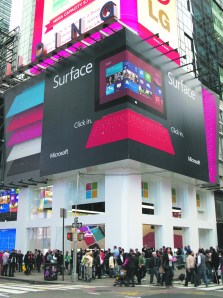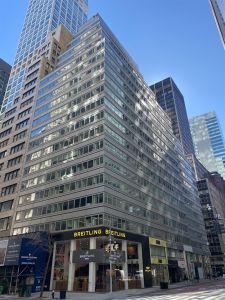Microsoft Among Wave of New Retailers to “Pop Up” Across Manhattan
By Billy Gray December 5, 2012 7:15 am
reprints Microsoft is cashing in on the critical, but fleeting, holiday shopping season with two ephemeral New York retail outlets. The software giant’s local pop-up stores opened Oct. 27 in Times Square and at The Shops at Columbus Circle, and purport to ease seasonal shopping anxiety with a “curated” selection of the company’s best products.
Microsoft is cashing in on the critical, but fleeting, holiday shopping season with two ephemeral New York retail outlets. The software giant’s local pop-up stores opened Oct. 27 in Times Square and at The Shops at Columbus Circle, and purport to ease seasonal shopping anxiety with a “curated” selection of the company’s best products.
But the holiday stores’ marquee piece will be Surface, the tablet that Microsoft (MSFT) shipped on the eve of the pop-ups’ opening. By pushing Surface using the pop-up platform, Microsoft is hewing to one of the retail model’s key tenets since it landed in New York about a decade ago.
Initially a form of stealth advertising and a way for retailers to wade into the waters of unfamiliar markets, pop-ups now increasingly qualify as retail events that attract, rather than chase, consumers and help make established companies seem hip rather than lend legitimacy to upstarts.
“There are two reasons why pop-ups continue to be popular: retailers want to test markets in new neighborhoods or, in Microsoft’s case, want to test new concepts,” said Faith Hope Consolo, chairwoman of the retail leasing and sales division at Douglas Elliman, who was not involved with Microsoft’s seasonal shops.
Microsoft, which currently has 30 permanent American retail locations, opened 30 holiday stores nationwide, doubling the exposure for Surface—and in many cases, bringing the company within laptop-chucking distance of arch-rival Apple’s outlets.
“Microsoft has been rolling out retail stores, but mostly in malls,” said Laura Pomerantz, a principal and founding partner of PBS Real Estate, who was not involved in Microsoft’s short-term leases. “They might want to test the street. Times Square and Columbus Circle certainly have a considerable amount of footfall, and diversified consumer bases. I think they’re competing with Apple, and Apple had great success with street retail.”
While heralding the arrival of Surface through pop-ups takes advantage of the retail model’s attention-getting formula, Microsoft’s seasonal stores arrive at a time when the template has evolved from its humbler roots. “When we first saw the trend, it really had more to do with guerilla marketing,” said Kelly Gedinsky, a director at Winick Realty Group, who did not work with Microsoft. She cited “untraditional retailers” like Vitamin Water as early adherents to the pop-up formula. “There was also the tendency of certain companies who couldn’t sell certain goods unloading them at secondary stores,” Ms. Gedinsky said.
The pop-up boom predated the Great Recession—it arrived in New York around 2003—but accelerated with the proliferation of vacant spaces during the downturn. Any stigma surrounding the concept as a way to hawk overstock items or hastily fill empty storefronts has largely dissipated among blue-chip retailers and landlords. “They don’t see it as a negative like a temporary store,” Ms. Consolo said.
Indeed, a significant development in the evolution of the pop-up store has been the diminishing importance of traditional retail points for certain companies, especially in the technology sphere. “Now there’s an interesting twist where the Internet has become a massive venue for retail sales,” Ms. Gedinsky said. “People are starting companies based on Internet sales without opening a store. They look to pop-ups to test brick-and-mortar outlets as a secondary market.”
That may not be the case for an established corporation like Microsoft. But the company, considered a relic by some on the cutting edge of tech, is no doubt well aware of the shifting retail patterns that pop-up stores are positioned to navigate. “With the increasing appeal of showrooming, or browsing products in stores before purchasing them at a lower cost online, pop-up shops will continue to flourish,” Russ Miller, a co-owner of Vacant, the company often credited with pioneering the formula in America, said in an email.
Microsoft’s holiday stores have certainly attracted a great number of browsers. Jonathan Adashek, general manager of strategy and communications at the company, said that more than 15 million customers have walked through the shops since they opened in late October. Mr. Adashek could not discuss asking rents at the 2,000-square-foot Times Square or 200-square-foot Columbus Circle shops. (Ms. Pomerantz would say that due to the “speculative” nature of pop-ups, landlords “usually charge a little more for pop-up than regular retail.”)
While many have visited Microsoft’s holiday shops, the company’s premier seasonal offering, Surface, is a device that enables the sort of digital retail that eliminates the need for a middleman between retailer and consumer. Should tablet technology continue to grow in popularity, there may come a time when people complete their holiday shopping without looking up from their devices or entering a tangible store, permanent or temporary.


